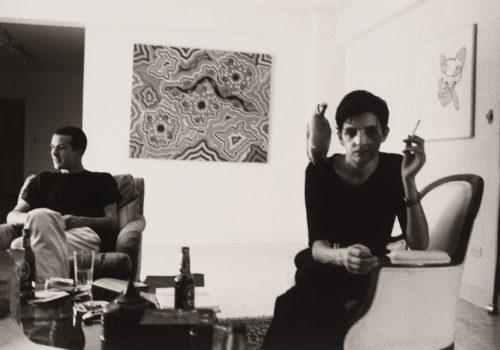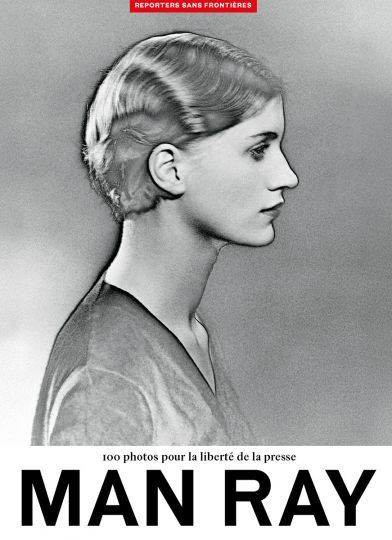Following the success of Allen Frame’s book Fever, (color photographs of his friends in New York in 1981), Gitterman Gallery presents rarely seen, vintage black and white prints from the same period in his career.
Frame came to New York in 1977 and began to photograph his friends in his apartment and theirs — intimately observed, unposed scenes that were influenced by his love of film and theater. After his first solo show in 1980, he found himself cast as Jack Nicholson in Gary Indiana’s play The Roman Polanski Story, starring his friend John Heys as Roman and Cookie Mueller as Sharon Tate. He was suddenly introduced to a world of downtown legends that included Bill Rice, Taylor Meade and Jack Smith. In the exhibition, Whereupon, a haunting photo of Heys and Mueller shows them coming out onto the terrace of Heys’ East Village penthouse terrace. There’s also a photograph of William Burroughs at home in the Bunker on the Bowery. Nan Goldin is seen sitting on Frame’s bed with artist Siobhan Liddell and a friend, their limbs mysteriously intertwined. Many of the same friends who appear in Fever show up in these black and white photographs: a self-portrait with painter friend Charlie Boone; Butch Walker with Charlie and his boyfriend Bill; a morning photo of a young man lying across a mattress on the floor as a young woman crosses the room. As Mark Alice Durant writes:
His images are not decisive moments, they are not exactly portraits, or figure studies either. They exist interstitially. A quiet intimacy and muted staging share the proscenium, as friends, acquaintances, and strangers pause and proceed through the mostly nocturnal tableaux. Allen’s photographs are unique in their elegant understatement, they observe without judgment, are melancholy but not sentimental, smolder without clamor.
Frame went from performing to directing and writing, adapting monologues by David Wojnarowicz with his friend Kirsten Bates for a theater production in Bill Rice’s backyard garden on East 3rd Street. He wrote about experimental theater in London for two years while directing a play he co-wrote with Bertie Marshall. Coming back to New York in 1987, he returned to photography and started teaching in 1992. His first monograph, Detour, black and white work from the 1990s, was published in 2001.
Like photographers from his own generation, such as Cindy Sherman, Nan Goldin, and Philip- Lorca Di Corcia, his vision is highly cinematic, but in his case, the framing and mise en scène have also been influenced by theater. As Nan Goldin wrote about Frame for a show at Galerie Polaris in Paris in 1990:
He does the improbable by using the medium of the still image to sustain a non-linear narrative, a narrative not explicated but implied. He doesn’t define his relationships with his friends—his subjects—as a series of seized moments of frozen time but as a flow of shared experiences, interactions, and emotions. Through his pictures we experience the open-ended nature of each moment, all that went before and will come after, the tension of the revelation of things not yet realized.
Born in Mississippi in 1951, Allen Frame grew up in the Delta town of Greenville, known for its literary culture and progressive Pulitzer Prize-winning newspaper. Shelby Foote and Walker Percy had gone to his high school and Southern writers like William Faulkner, Tennessee Williams, and Carson McCullers, were a huge inspiration.
He won the Rome Prize in photography in 2017/18, and spent a year in Italy. After residencies in St. Petersburg and Ekaterinburg, Russia, through CEC Artslink in 2019, he returned to Italy in 2021 as a Director’s Guest at Civitella Ranieiri in Umbria. Much of his recent work has been made in Italy. He is a big fan of Italian filmmakers of the 1950s and 60s, particularly Michelangelo Antonioni, because of his emphasis on mood, atmosphere and character over plot, exploring psychological states of mind. In his foreign travels, he gathers old photographs, drawings, and paintings to use with his own work to make sprawling wall pieces that have been shown at Pratt Institute in 2018 and in his exhibition, Suddenly, at Gitterman Gallery in 2019. He has made three chapbook/zines with photographer/book designer Michaela Palermo in Sicily: Suddenly, Sorry for Your Loss, and Boy on a Dolphin. His forthcoming book, Innamorato, will be published by Meteoro Editions later this year.
Frame’s contact with younger artists through teaching, curating, and writing have kept him at the center of New York’s photography world for 40 years. He was instrumental in the revival of the Camera Club of New York and transforming it into the cutting-edge Baxter Street. In the last year he has written three essays about the artist Darrel Ellis, who is prominently featured in Fever. Frame’s photos of Ellis were published in the summer edition of the Spanish magazine Apartamento, and Frame’s and Ellis’ photos were shown together at Crone Galerie in Vienna in 2022. In 2023, Frame and Sergio Bessa will co-curate a show of Ellis and other artists he was associated with, coinciding with the exhibition Darrel Ellis: Regeneration, which will come to the Bronx Museum of the Arts in May after opening at the Baltimore Museum of Art.
Frame has been the curator of numerous exhibitions, including, Shohei Miyachi and Context at Matte HQ in 2021; Love and Jump Back, the Photography of Charles Henri Ford, at Mitchell Algus Gallery in New York in 2020; and Darrel Ellis at Art in General in 1996. He created the epic activist slide projection piece Electric Blanket about AIDS with Nan Goldin and Frank Franca and toured it in the U.S. and internationally through Visual AIDS, from 1990–2002. He is an Adjunct Professor of Photography at Pratt Institute (MFA) and also teaches at the School of Visual Arts (BFA), the International Center of Photography in New York, and online for Strudelmedia.
Allen Frame : Whereupon
Until November 5, 2022
Gitterman Gallery
3 East 66th street, 1b New York, NY 10065
212.734.0868
www.gittermangallery.com
















